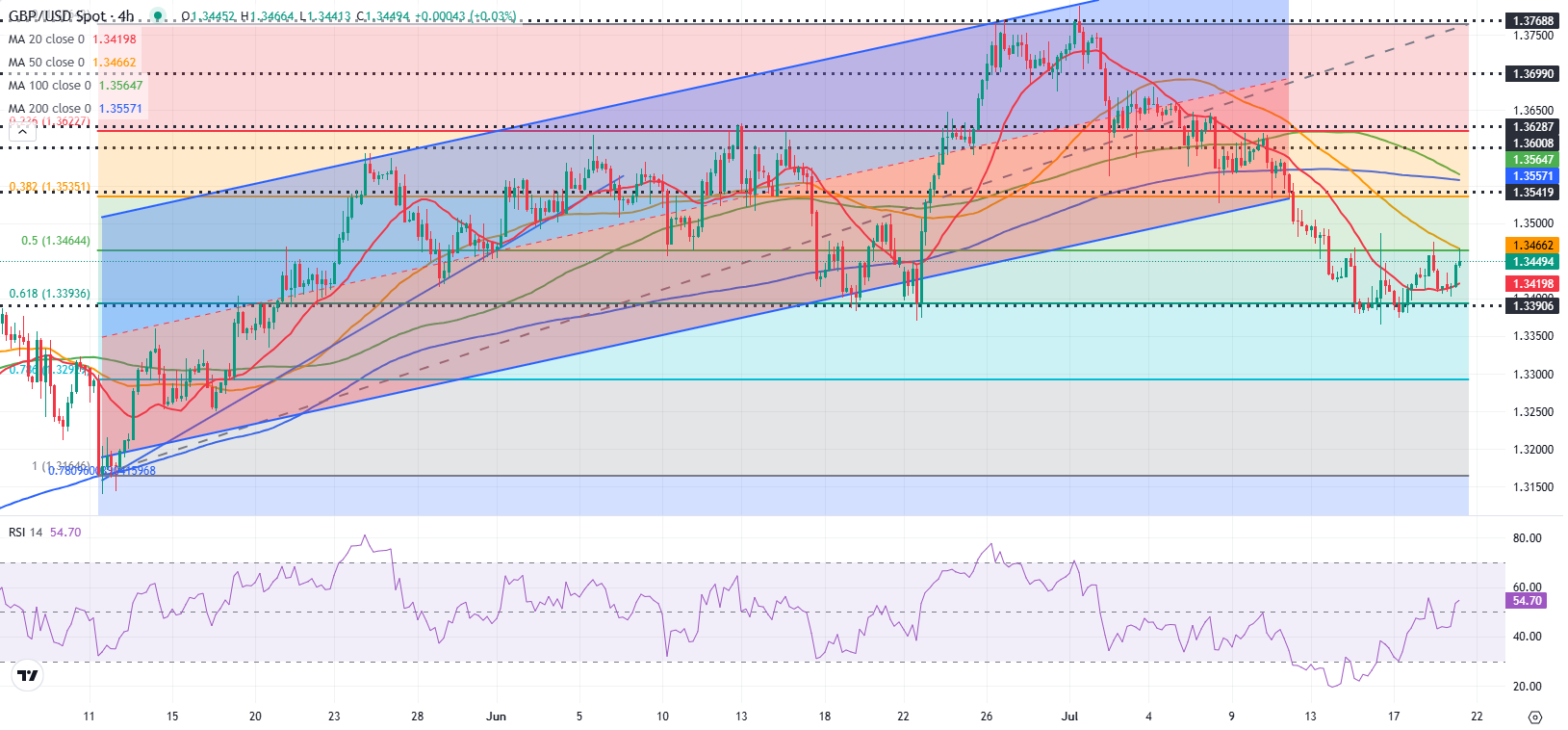
- GBP/USD trades in positive territory near 1.3450 on Monday.
- The US Dollar could struggle to find demand in case markets remain risk-positive.
- The economic calendar will not feature any high-tier data releases.
After ending the previous week in negative territory and posting losses for the third consecutive week, GBP/USD corrects higher and trades at around 1.3450 in the European session on Monday. The pair’s technical outlook points to a loss of bearish momentum.
British Pound PRICE Today
The table below shows the percentage change of British Pound (GBP) against listed major currencies today. British Pound was the strongest against the New Zealand Dollar.
| USD | EUR | GBP | JPY | CAD | AUD | NZD | CHF | |
|---|---|---|---|---|---|---|---|---|
| USD | -0.11% | -0.24% | -0.07% | 0.07% | 0.01% | 0.17% | -0.13% | |
| EUR | 0.11% | -0.06% | 0.05% | 0.15% | 0.09% | 0.10% | -0.06% | |
| GBP | 0.24% | 0.06% | -0.10% | 0.26% | 0.18% | 0.37% | 0.19% | |
| JPY | 0.07% | -0.05% | 0.10% | 0.14% | 0.12% | 0.19% | 0.11% | |
| CAD | -0.07% | -0.15% | -0.26% | -0.14% | 0.00% | 0.10% | -0.25% | |
| AUD | -0.01% | -0.09% | -0.18% | -0.12% | -0.01% | 0.09% | 0.01% | |
| NZD | -0.17% | -0.10% | -0.37% | -0.19% | -0.10% | -0.09% | -0.18% | |
| CHF | 0.13% | 0.06% | -0.19% | -0.11% | 0.25% | -0.01% | 0.18% |
The heat map shows percentage changes of major currencies against each other. The base currency is picked from the left column, while the quote currency is picked from the top row. For example, if you pick the British Pound from the left column and move along the horizontal line to the US Dollar, the percentage change displayed in the box will represent GBP (base)/USD (quote).
The improving risk mood makes it difficult for the US Dollar (USD) to stay resilient against its rivals at the beginning of the week and helps GBP/USD stretch higher. At the time of press, the UK’s FTSE 1000 Index was trading marginally higher on the day, while US stock index futures were up about 0.3%. In case risk flows continue to dominate the action in financial markets in the second half of the day, GBP/USD could build on its daily gains.
Meanwhile, a Deloitte survey showed early Monday that the consumer sentiment in the UK deteriorated noticeably in the second quarter, with its Consumer Confidence Index dropping by 2.6 percentage points to its lowest level since the first quarter of 2024 at 10.4%.
“Concerns of a slowing labour market have left consumers worried about job security and income growth prospects, while persistent inflation and a high cost of living have negatively impacted sentiment towards personal debt,” said Celine Fenech, Deloitte consumer insight lead, per Reuters.
The economic calendar will not offer any high-tier data releases that could influence GBP/USD’s action in the first half of the week. Hence, the pair could have a difficult time finding direction. On Thursday, the preliminary July Manufacturing and Services Purchasing Managers’ Index (PMI) data from the UK and the US will be watched closely by investors.
GBP/USD Technical Analysis

GBP/USD pulled away from the 20-period Simple Moving Average (SMA) on the 4-hour chart after fluctuating at around that level earlier in the day and the Relative Strength Index (RSI) indicator rose above 50, highlighting a loss of bearish momentum.
Looking north, the first resistance level could be spotted 1.3470 (Fibonacci 50% retracement, 50-period SMA) ahead of 1.3500 (static level, round level) and 1.3540 (Fibonacci 38.2% retracement). On the downside, support levels could be seen at 1.3400-1.3390 (round level, Fibonacci 61.8% retracement) and 1.3300 (Fibonacci 78.6% retracement).
Pound Sterling FAQs
The Pound Sterling (GBP) is the oldest currency in the world (886 AD) and the official currency of the United Kingdom. It is the fourth most traded unit for foreign exchange (FX) in the world, accounting for 12% of all transactions, averaging $630 billion a day, according to 2022 data. Its key trading pairs are GBP/USD, also known as ‘Cable’, which accounts for 11% of FX, GBP/JPY, or the ‘Dragon’ as it is known by traders (3%), and EUR/GBP (2%). The Pound Sterling is issued by the Bank of England (BoE).
The single most important factor influencing the value of the Pound Sterling is monetary policy decided by the Bank of England. The BoE bases its decisions on whether it has achieved its primary goal of “price stability” – a steady inflation rate of around 2%. Its primary tool for achieving this is the adjustment of interest rates. When inflation is too high, the BoE will try to rein it in by raising interest rates, making it more expensive for people and businesses to access credit. This is generally positive for GBP, as higher interest rates make the UK a more attractive place for global investors to park their money. When inflation falls too low it is a sign economic growth is slowing. In this scenario, the BoE will consider lowering interest rates to cheapen credit so businesses will borrow more to invest in growth-generating projects.
Data releases gauge the health of the economy and can impact the value of the Pound Sterling. Indicators such as GDP, Manufacturing and Services PMIs, and employment can all influence the direction of the GBP. A strong economy is good for Sterling. Not only does it attract more foreign investment but it may encourage the BoE to put up interest rates, which will directly strengthen GBP. Otherwise, if economic data is weak, the Pound Sterling is likely to fall.
Another significant data release for the Pound Sterling is the Trade Balance. This indicator measures the difference between what a country earns from its exports and what it spends on imports over a given period. If a country produces highly sought-after exports, its currency will benefit purely from the extra demand created from foreign buyers seeking to purchase these goods. Therefore, a positive net Trade Balance strengthens a currency and vice versa for a negative balance.
Information on these pages contains forward-looking statements that involve risks and uncertainties. Markets and instruments profiled on this page are for informational purposes only and should not in any way come across as a recommendation to buy or sell in these assets. You should do your own thorough research before making any investment decisions. FXStreet does not in any way guarantee that this information is free from mistakes, errors, or material misstatements. It also does not guarantee that this information is of a timely nature. Investing in Open Markets involves a great deal of risk, including the loss of all or a portion of your investment, as well as emotional distress. All risks, losses and costs associated with investing, including total loss of principal, are your responsibility. The views and opinions expressed in this article are those of the authors and do not necessarily reflect the official policy or position of FXStreet nor its advertisers. The author will not be held responsible for information that is found at the end of links posted on this page.
If not otherwise explicitly mentioned in the body of the article, at the time of writing, the author has no position in any stock mentioned in this article and no business relationship with any company mentioned. The author has not received compensation for writing this article, other than from FXStreet.
FXStreet and the author do not provide personalized recommendations. The author makes no representations as to the accuracy, completeness, or suitability of this information. FXStreet and the author will not be liable for any errors, omissions or any losses, injuries or damages arising from this information and its display or use. Errors and omissions excepted.
The author and FXStreet are not registered investment advisors and nothing in this article is intended to be investment advice.








